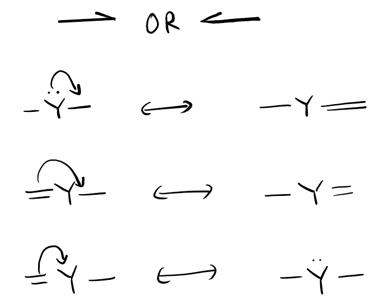Movement of Electrons in Chemical Reactions
Understanding the movement of electrons is essential for chemists to predict and explain the behavior of molecules during chemical reactions.
Chemical reactions involve the rearrangement of atoms and the breaking and forming of chemical bonds. At the heart of these processes lies the movement of electrons, which play a crucial role in determining the outcome of the reaction.
Curved Arrow Notation
To represent the movement of electrons in chemical reactions, chemists commonly use curved arrow notation. This notation provides a visual representation of electron flow, indicating the movement of electron pairs or single electrons from one atom to another. Curved arrows are drawn above or below the reaction arrow, with the arrowhead pointing to the atom that gains or receives the electron(s).
Half-Headed Curved Arrows or Fish hooks
Half-headed curved arrows are a specific type of curved arrow notation commonly used to represent the movement of a single electron. These arrows have a half-arrowhead, which indicates the movement of a single electron from a lone pair or a bond to an empty orbital. Half-headed curved arrows are particularly useful in reactions involving radical species or reactions with transition metals.
For example, in a radical reaction, a single electron is transferred from a radical species to another atom or molecule. The movement of this single electron can be represented using a half-headed curved arrow, clearly illustrating the flow of the unpaired electron.
Fish hooks are another type of curved arrow notation used to represent the movement of electron pairs. They are called fish hooks because of their resemblance to the shape of a fishing hook. Fish hooks are particularly useful in reactions involving nucleophiles and electrophiles.
In a nucleophilic reaction, a nucleophile, which is an electron-rich species, donates a pair of electrons to an electrophile, which is an electron-deficient species. This donation of electron pairs can be represented using a fish hook curved arrow, indicating the flow of the electron pair from the nucleophile to the electrophile.
Similarly, in an electrophilic reaction, an electrophile accepts a pair of electrons from a nucleophile. The movement of the electron pair can be represented using a fish hook curved arrow, showing the flow of the electron pair from the nucleophile to the electrophile.
By using curved arrow notation, including half-headed curved arrows and fish hooks, chemists can effectively communicate the movement of electrons in chemical reactions. This notation allows for a clear understanding of electron flow, aiding in the analysis and prediction of reaction mechanisms.
Overall, understanding the movement of electrons in chemical reactions is vital for chemists to unravel the intricacies of molecular transformations. Curved arrow notation, including half-headed curved arrows and fish hooks, provides a powerful tool for representing electron flow and helps chemists decipher the mechanisms behind chemical reactions.


